The Bagpipe Society
Bourdon Collectif
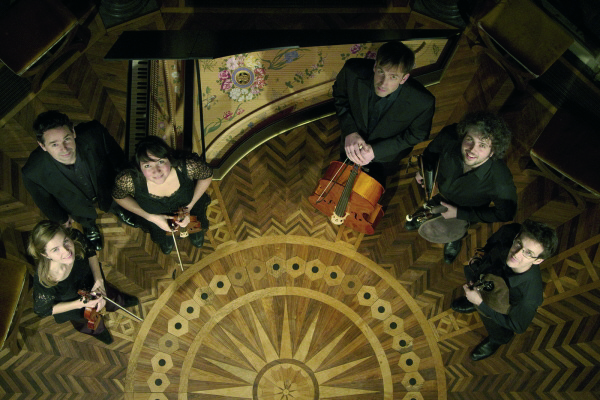
Bourdon Collectief or “Drone Collective” is so called because it is the drone, together with the continuous sound of the melody, that defines our concerts. Not well known, but central to the setting of this ensemble, are the two musettes, also known as musette baroque or musette de cour as it was a very popular instrument in 17th and 18th century France. Many composers wrote for this instrument and it is our mission to present their music in an authentic instrumentation.
The Bourdon Collectief is the only permanent ensemble with two musette players in the world, founded in December 2013 by Pieterjan Van Kerckhoven and Bart Van Troyen. They have played as a duo since 2011, but the idea of playing in a larger formation was so tempting they decided to invite some friends to join them. The ensemble was reinforced by Naomi Vercauteren and Marieke Vos on baroque violin, Dieter Vanhandenhoven at the harpsichord and on the cello at first Pieter Stas. From the beginning it was clear that Pieter would not have enough time to be permanent member of the ensemble, and one of his colleagues, Herlinde Verheyden joined the Bourdon Collectief. However, it is the drones are the main feature of the ensemble, whether they play as a sextet oo a duet.
In February 2014 they made a demo-recording in a beautiful castle in Bornem near Antwerp which had been designed by the French court architect, Charles De Wailly (1730-1798). You can see some details on the pictures, especially the remarkable woodwork in the beautiful floor. This recording was made to present the ensemble in Belgium and can still be found on youtube. In August of that year the Bourdon Collectief, in its larger setting, was elected as a laureate for the International Young Artist Presentation - a project of Musica, Impulse Centre for Music, realized by AMUZ (Flanders Festival-Antwerp). Amongst other performances, this resulted in a live recording for WDR3 (Köln, Germany) in February 2015 and a concert in the stunning Château d’Ursel (Hingene, Belgium). Exactly one year later, in February 2016 they landed in Scotland for the first time to play at the International Bagpipe Organisation’s conference, organized by Cassandre Balbar. The event was held in the National Piping Center at Glasgow and the opening concert was in remembrance of Jean-Christophe Maillard, the pioneer of musette playing, who had passed away in Jjuly 2015. It is thanks to him that the musette was revived, his effort as musician and musicologist cannot be overestimated.
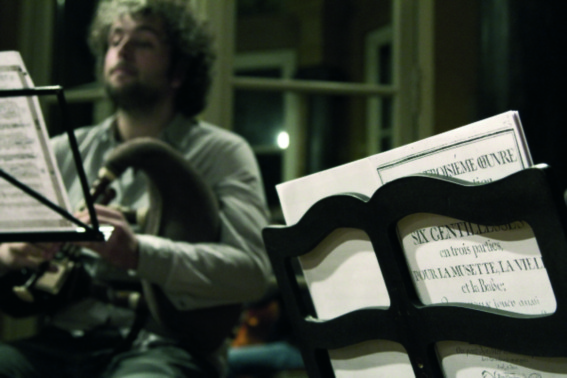
The concert was highly appreciated, especially by the Scottish hosts and the Bourdon Collectief got invited to preform at their music festival Piping Live! 2016 in Glasgow. Indeed, ladies and gentlemen, after this concert a Gordian knot has been cut: Bourdon Collectief will record their first album in summer 2017.
The repertoire: highly digestible baroque music (for drone lovers)
In France of the 17th and 18th century there is a trend to glorify the pastorale. Folk-instruments, such as bagpipes and hurdy-gurdys, get their place at the Court of Versailles. A drone is something special and curious (isn’t it?) and that is what they loved about it. They used expensive materials like ebony, ivory, silver for the 12 keys and silk to modify the instruments to what is known as the baroque musette today. This must have opened their eyes, together with the ingenious way the drones and the two chanters are made.
Well, people who believe harmony and drones don’t work together are proven to be mistaken. There was a lot of music was written for the musette from this period. Sonatas for musette with basse continue (continuous bass or figured bass, the composer writes a bottom line and add figures to indicate the harmony that should be used by the keyboard player), concerto’s, cantatas as well as a lot of duo’s for two musettes can be found. The instrument was also used in opera’s, for example La temple de la Gloire by Jean Philippe Rameau (1683-1764).
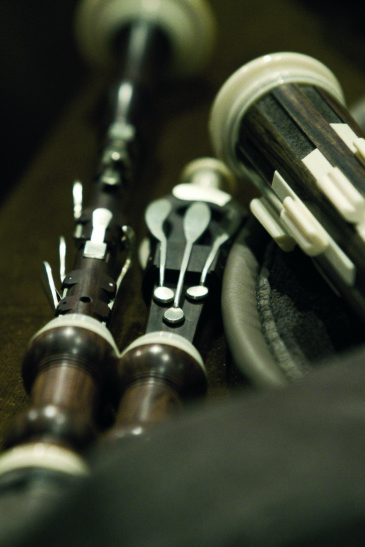
The music for musette was often written by French composers who are not always known by the larger public. But some names like Lully, Rameau, Boismortier, Chédeville or Hotteterre may ring a bell. The use of drones in classical music has always been a bit controversial, even in the 17th and 18th century, but this last composer, Jacques Martin Hotteterre (1674-1763) explicitly says in his Méthode pour la Musette not to plug the drones. In the preparation to a concert some years ago, someone told me: “Oh, the musette is so great to play with. It is such a complete instrument”, and I cannot disagree. The instrument fills the room with all its sounds. The beautiful combination of drones together with the harmony gives a specific colour to music of this period.
Often composers who wrote for the instrument were musette players themselves. They knew the character of the musette very well and wrote beautiful music for this instrument, either solo or for a larger setting. With the drone and continuous sound as main characteristics of most bagpipes, you will not find many silences written down in the scores of the musette. The use of the drone is never written down in the scores, but in the way of composing you will see that the drone fits the harmony used by the composer. There are little modulations and modulations are briefly and never very exotic, mostly to the key of the 5th.
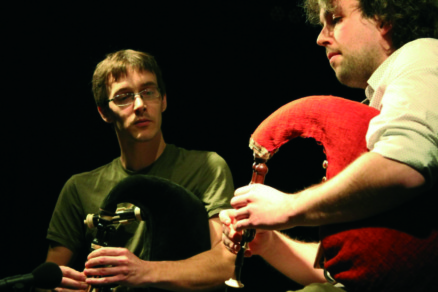
On the album of Bourdon Collectief you will find compositions by Joseph Bodin de Boismortier, Nicolas Chédeville, Michel Corrette, Philippe Dugué and Jacques-Christophe Naudot. The goal of the Bourdon Collectief is to convince the audience of the beauty of this music in its original orchestration and to revalue the music of Boismortier, Chédeville and their contemporaries. Often regarded as inferior, or preformed without the intended instruments, their works deserve to be heard the way the composer intended.
The instrument: more than glitter and glamour
The musette, with its silver and ivory, is a fancy instrument and is seen as part of French decadence of the 18th century. At the end of the French monarchy and with the French Revolution, the instrument was banned. But since the second half of last century there was a renewed interest in the instrument thanks to the maker, Remy Dubois, and pioneer musette players Jean-Christophe Maillard and Jean-Pierre Van Hees.
Although it’s glitter and glamour you see at first sight, in it’s heyday the musette was the pinnacle of instrument making techniques. The instrument is remarkable for being fully chromatic and that is achieved without any cross fingering as their is either a key or a hole for each note. The complexity of the instruments are made with a great craftsmanship and the musettes we play today are copies of an original musette of Chédeville made by Remy Dubois. It is down to his hard work of the last 30 years, that we have this fine instruments today.
The musette distingues itself from other bagpipes in two ways: the advanced shuttle drone and two (or more) chanters.
The shuttle drone containes five reeds in a small piece of wood/ivory. For musette du cinq, in G-C in 392 (real sound F-Bflat), the length of the shuttle drone without reeds and dôme (ornamentation at the end) is only 165mm. There are two different tuning possibilities: C or G. The little drone, which is called dessus gives the same G as the main chanter. The second drone is called haute-contre and has two options: D or C. The next in line is Tierze which gives an E, the major third when played pieces in C major. The forth is called Taille and gives a G, one octave lower then the main chanter. The base drone or basse gives a C or G drone. So basically you always have a fifth in the drones G-D or C-G, and only for the C major pieces without modulation you can add the full C major chord in the drones.
All the reeds used in the baroque musette are double reeds. Because of the modest volume of the instrument, the reeds are quite large, thin and with a rather small opening. To keep all those reeds in good shape (read: in tune), it’s necessary that they are kept in stable conditions with good humidity and therefore the instrument is blown by a bellow. Making the reads is quite a job as all reeds should sound in balance with the same pressure. With the words of le maître Remy Dubois: it’s a never ending research.
This instrument distinguishes itself from many other bagpipes with its two chanters. Two chanters which have their own reed. The main chanter is played with both hands, the little one to be touched by your left pinkie and right thumb. The main chanter is fully chromatic, but that wasn’t enough for Martin Hotteterre. He added the second chanter, which is called Petit Chalumeau to extend the range. Because of the two reeds the possibility of playing in two voices was discovered and used. In a concert of the Bourdon Collectief when you listen to a duo of Bart and Pieterjan, at some moments you’ll actually hear three voices at the same time.
There is much more to say about the instrument but it would take too much space in this article. I suggest you read some articles by Jean-Christophe Maillard or the book written by Jean-Pierre Van Hees, which will soon be available in English.
The future of musette making: Bart Van Troyen
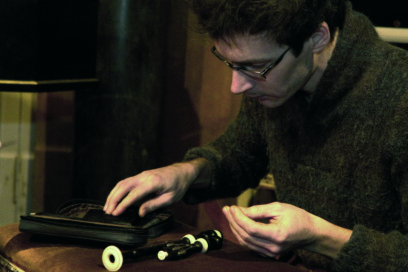
In December 2016, I (Pieterjan) got married and one of the nicest gifts was one of the first instruments to be built by Bart. It is not because of that wedding gift, or because of the reduction Bart should give me on my next instrument order, that I’m writing this section. It is because it is important for the continuation of musette playing that young people learn the skills of bagpipe making. For the last year and a half, Bart is learning the craft, under the seeing eye of Remy Dubois, to build all parts of the musette. Together they have made musettes and developed a new type of study instrument in D, based on the musette d’amore. To lower costs it is mouth blown, with a drone over the shoulder but till with the sound of a musette and with the choice of playing either open or semi-closed fingering.
Bart has made a great effort and a big investment in materials to make proper, well-sounding instruments with respect for the high standard of building that Remy always has kept in mind. Beautiful ornamented instruments with the highest quality of sound. If you want to learn more about his new model musettes, you can contact him via the information at the end of this article.
About Pieterjan and Bart
At age 17, Pieterjan Van Kerckhoven (°1988) started playing the Flemish bagpipes with Bart Van Troyen (°1978). They haven’t stopped playing together since, but it took them several years until they started performing as an ensemble in 2013.
Both Bart and Pieterjan hold a masters degree in folk & baroque music and a masters degree in chamber music from LUCA School of Arts (Leuven) where they studied with Jean-Pierre Van Hees. Together they attended masterclasses in Toulouse with Jean-Christophe Maillard. Nowadays, they teach bagpipes and musette de cour throughout Belgium. Aside from that, Pieterjan focuses mainly on playing with his folk bands WÖR, Surpluz and EmBRUN, whilst Bart is an apprentice to Remy Dubois, who is the world’s greatest maker of musettes de cour.
If you need of more information or are interested in booking the group, don’t hesitate to make contact: bourdoncollectief@gmail.com or add us on Facebook.
By International Bagpipe Organisation Van Kerckhoven, Pieterjan
From Chanter Spring 2017.
- Data Processing Notice (GDPR)
@BagpipeSociety on X (formally known as Twitter)
TheBagpipeSociety on Instagram
 BagpipeSociety on Facebook
BagpipeSociety on Facebook
Something wrong or missing from this page? Let us know!
